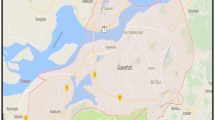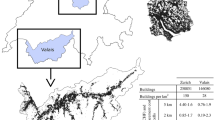Abstract
Through this paper we propose and test a GIS framework that addresses the issue of seismic risk due to urban road network failure. The approach relies on full GIS integration, on Monte Carlo simulations for generating potentially disrupted network configurations, considering also the damage probability due to direct earthquake implications, and on traffic considerations (both in typical and post-earthquake situations). The damage probability can be obtained using fragility functions for critical structures like bridges and tunnels or by determining empirically the possibility of affected buildings to generate debris leading to road obstruction. Multiple performance indicators such as travel time and distance under various conditions are combined, in order to quantify the risks inflicted by dysfunctionalities in the emergency intervention process. The framework considers at the same time temporal and spatial dimensions, being able to cope with traffic dynamics or reconfigurable network configurations. The ArcGIS Network Analyst Module is used for model integration, and full city scale analysis is performed in order to test the capabilities. Bucharest (capital of Romania) is selected for the case study; this 2 million inhabitant city is one of the most endangered in Europe, due to earthquakes that occur in the Vrancea Area, at intermediate depth, with moment magnitudes > 7, but also due to the vulnerable building stock. Beside this, it is one of Europe’s top cities when it comes to traffic congestion. The results of the study provide initial insights on the deficiencies of the city’s road network and connectivity limitations, showing the high impact of road obstructions and traffic congestion on intervention times, for ambulances and firefighters, in case of an earthquake.

Sources: Paul Harris/Getty Images and Yozo Fujino

Sources: AP Images and Danish Ismail/Reuters






Similar content being viewed by others
References
Anbazhagan P, Srinivas S, Chandran D (2012) Classification of road damage due to earthquakes. Nat Hazards 60:425–460
Argyroudis SA, Pitilakis KD, Anastasiadis AI (2005) Roadway network seismic risk analysis in urban areas: the case of Thessaloniki—Greece. In: Proceedings of Geoline, Lyon, France
Argyroudis S, Selva J, Gehl P, Pitilakis K (2015) Systemic seismic risk assessment of road networks considering interactions with the built environment. Comput Aided Civil Infrastruct Eng 30:524–540
Basoz N, Kiremidjian A, King S, Law K (1999) Statistical analysis of bridge damage data from the 1994 Northridge, CA, earthquake. Earthq Spectra 15(1):25–54
Bono F, Gutierrez E (2011) A network-based analysis of the impact of structural damage on urban accessibility following a disaster: the case of the seismically damaged Port Au Prince and Carrefour urban road networks. J Transp Geogr 19:1443–1455
(BGM) Bucharest General Municipality (2016) List of buildings technically expertise, classified into seismic risk classes. www.pmb.ro. Accessed 29 Jan 2016
Caiado G, Oliveira C, Ferreira MA, Sa F (2012) Assessing urban road network seismic vulnerability: an integrated approach. In: Proceedings of the 15WCEE, Lisbon, Portugal
Cardone D (2013) Displacement limits and performance displacement profiles in support of direct displacement-based seismic assessment of bridges. Earthq Eng Struct Dyn 43(8):1239–1263
Chang L, Elnashai AS, Spencer B Jr (2012) Post-earthquake modelling of transportation networks. Struct Infrastruct Eng 8(10):893–911
Coburn A, Spence E (2002) Earthquake protection. Wiley, Hoboken
Crowley H, Colombi M, Silva V, Monteiro R, Ozcebe S, Fardis M, Tsionis G, Askouni P (2011) Fragility functions for roadway bridges, D3.6 of the SYNER-G Project
Ditlevsen O, Madsen HO (1996) Structural reliability methods. Wiley, Chichester
Douglas J, Serrano JJ, Comte J, Bouc O, Arnal C, Robida F, Modaressi H, Logtmeijer C, Vowles G, Holt I (2007) Risk assessment for the road network in the French-Italian border region using web services. In: 17th IIASA-DPRI forum on integrated disaster risk management, Stresa, Italia
Fardis MN (2009) Seismic design, assessment and retrofitting of concrete buildings. Springer, Berlin
FEMA (2014) HAZUS-MH: Multi-hazard Loss Estimation Methodology. http://www.fema.gov/hazus. Accessed 21 Feb 2016
Fleischhauer M (2008) The role of spatial planning in strengthening urban resilience. In: Kirillov IA, Pasman HJ (eds) Resilience of cities to terrorist and other threats. Springer, Berlin
Franchin P, Lupoi A, Pinto PE (2006) On the role of road networks in reducing human losses after earthquakes. J Earthq Eng 10(2):195–206
Franchin P, Cavalieri F, Pinto P et al (2011) General methodology for systemic vulnerability assessment, D2.1 of the SYNER-G Project
Giardini D, Woessner J, Danciu L, Crowley H, Cotton F, Grünthal G, Pinho R, Valensise G, SHARE consortium (2013) SHARE European seismic hazard map for peak ground acceleration, 10% exceedance probabilities in 50 years. https://doi.org/10.2777/30345
Goretti A, Sarli V (2006) Road network and damaged buildings in urban areas: short and long-term interaction. Bull Earthq Eng 4:159–175
Hadas Y, Rossi R, Gastaldi M, Pellegrino C, Zanini MA, Modena C (2015) Optimal critical infrastructure retrofitting model for evacuation planning. Transp Res Procedia 10:714–724
Karaca E (2005) Regional earthquake loss estimation: role of transportation network, sensitivity and uncertainty, and risk mitigation. Ph.D. Thesis, MIT, Cambridge, MA
Karduni A, Kermanshah A, Derrible S (2016) A protocol to convert spatial polyline data to network formats and applications to world urban road networks. Scientific Data, Vol. 3, Nature Publishing Group, https://doi.org/10.1038/sdata.2016.46
Kawashima K, Matsuzake H (2012) Damage of road bridges by 2011 Great East Japan (Tohoku) earthquake. In: Proceedings of the 15WCEE, Lisbon, Portugal
Kumar R, Gardoni P (2014) Effect of seismic degradation on the fragility of reinforced concrete bridges. Eng Struct 79:267–275
Marmureanu G, Cioflan CO, Marmureanu A (2010) Researches on local seismic hazard (microzonation) for metropolitan Bucharest area (in Romanian: Cercetari privind hazardul seismic local (microzonare) a zonei metropolitane Bucuresti). Tehnopress, Iasi
Morbin R, Zanini MA, Pellegrino C, Zhang H, Modena C (2015) A probabilistic strategy for seismic assessment and FRP retrofitting of existing bridges. Bull Earthq Eng 13(8):2411–2428
National Institute for Statistics (2015) Registered vehicles that are in circulation. http://statistici.insse.ro/shop/index.jsp?page=tempo3&lang=ro&ind=TRN103B. Accessed 15 Mar 2017
Nuti C, Vanzi I (1998) Assessment of post-earthquake availability of hospital system and upgrading strategies. Earthq Eng Struct Dyn 27(12):1403–1423
Pitilakis KD, Kakderi KG (2011) Seismic risk assessment and management of lifelines, utilities and infrastructures. In: Proceedings of the 5th ICEGE, Santiago, Chile
RISK-UE (2001–2004) An advanced approach to earthquake risk scenarios with applications to different European towns. Research Project, European Commission, DG ΧΙI2001-2004, CEC Contract Number: EVK4-CT-2000-00014
Sevtsuk A, Mekonnen M (2012) Urban network analysis: a new toolbox for ArcGIS. Revue Internationale de Geomtique 22(2):287–305
Shahabi K, Wilson JP (2014) CASPER: intelligent capacity-aware evacuation routing. Comput Environ Urb Syst 46:12–24
Toma-Danila D, Armas I (2017) Insights into the possible seismic damage of residential buildings in Bucharest, Romania, at neighborhood resolution. Bull Earthq Eng 15(3):1161–1184
TomTom (2017) TomTom traffic index. https://www.tomtom.com/en_gb/trafficindex. Accessed 15 Mar 2017
Veneziano D, Sussman J, Gupta U, Kunnumkal SM (2002) Earthquake loss under limited trasnsportation capacity: assessment, sensitivity and remediation. In: Proceedings 7th USNCEE, Boston, MA, USA
Zanini MA, Faleschini F, Zampieri P, Pellegrino C, Gecchele F, Gastaldi M, Rossi R (2017) Post-quake urban road network functionality assessment for seismic emergency management in historical centres. Struct Infrastruct Eng 17(9):1117–1129
Acknowledgements
This work was supported by The Executive Unit for Financing the Higher Education and University Researches (UEFISCDI); through the NUCLEU CREATOR Programme, Project Nr. PN-16-35-02-03. We also acknowledge the contribution of the doctoral scholarship from Faculty of Geography, University of Bucharest.
Author information
Authors and Affiliations
Corresponding author
Rights and permissions
About this article
Cite this article
Toma-Danila, D. A GIS framework for evaluating the implications of urban road network failure due to earthquakes: Bucharest (Romania) case study. Nat Hazards 93 (Suppl 1), 97–111 (2018). https://doi.org/10.1007/s11069-017-3069-y
Received:
Accepted:
Published:
Issue Date:
DOI: https://doi.org/10.1007/s11069-017-3069-y




